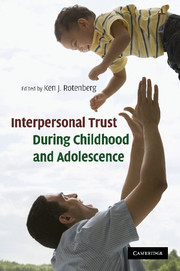Book contents
- Frontmatter
- Contents
- List of figures
- List of tables
- List of contributors
- Section I Conceptual foundations and issues
- Section II Childhood
- Section III Adolescence and early adulthood
- 10 Trust, but verify: Knowledge, disclosure, and mothers' beliefs about adolescents' trustworthiness
- 11 The role of trust in adolescent–parent relationships: To trust you is to tell you
- 12 A new scale for the assessment of adolescents' trust beliefs
- 13 A friend in need is a friend indeed: Exploring the relations among trust beliefs, prosocial tendencies, and friendships
- 14 Promoting intergroup trust among adolescents and young adults
- Index
- References
13 - A friend in need is a friend indeed: Exploring the relations among trust beliefs, prosocial tendencies, and friendships
Published online by Cambridge University Press: 04 August 2010
- Frontmatter
- Contents
- List of figures
- List of tables
- List of contributors
- Section I Conceptual foundations and issues
- Section II Childhood
- Section III Adolescence and early adulthood
- 10 Trust, but verify: Knowledge, disclosure, and mothers' beliefs about adolescents' trustworthiness
- 11 The role of trust in adolescent–parent relationships: To trust you is to tell you
- 12 A new scale for the assessment of adolescents' trust beliefs
- 13 A friend in need is a friend indeed: Exploring the relations among trust beliefs, prosocial tendencies, and friendships
- 14 Promoting intergroup trust among adolescents and young adults
- Index
- References
Summary
Caring, as helping another grow and actualize himself, is a process, a way of relating to someone that involves development, in the same way that friendship can only emerge in time through mutual trust and a deepening and qualitative transformation of the relationship.
(Mayeroff, 1971, p. 1)The recent movement in positive psychology has beckoned a call for more attention to the strengths and positive aspects of human functioning (Seligman and Csikszentmihalyi, 2000). Much of the intellectual basis for this recent movement in psychology stems from a reemergence of an interest in philosophical perspectives on what constitutes a good and moral life. Not surprisingly, scholars have long noted that prosocial tendencies (e.g., kindness, caring, helping) and trust are basic elements of persons with strong moral and good character (e.g., Aristotle, 1980; Blum, 1980; Mayeroff, 1971; Noddings, 2003; Rotter, 1980). The belief that trust and prosocial tendencies are basic elements of moral character also extends the notion that these are markers of close, interpersonal relationships. As Bukowski and Sippola (1996) noted, “particular qualities are essential for ‘morally excellent’ friendships. These qualities include: (a) a deep concern for the other for his or her own sake … (c) high levels of trust and commitment to the relationship” (p. 245). These authors further assert that there are conceptual reasons to expect ties between trust and prosocial tendencies – that, indeed, friendship requires goodness.
In his classic essay, On caring, Milton Mayeroff (1971) eloquently introduces to us the intricate links between caring, helping, trust, and interpersonal relationships.
- Type
- Chapter
- Information
- Interpersonal Trust during Childhood and Adolescence , pp. 270 - 294Publisher: Cambridge University PressPrint publication year: 2010
References
- 9
- Cited by



